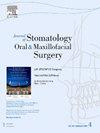Transconjunctival lower blepharoplasty with orbital fat repositioning versus fat grafting for tear trough deformity: A prospective, comparative and randomized study
IF 2
3区 医学
Q2 DENTISTRY, ORAL SURGERY & MEDICINE
Journal of Stomatology Oral and Maxillofacial Surgery
Pub Date : 2025-04-01
DOI:10.1016/j.jormas.2025.102320
引用次数: 0
Abstract
Background
Fat prolapse and tear trough deformity, indicative of lower eyelid aging, are increasingly prevalent in younger patients. Transconjunctival lower blepharoplasty (TCLB) is a suitable treatment for this demographic; however, traditional techniques have limitations that affect their simplicity and effectiveness.
Objective
We conducted a prospective, randomized controlled trial to systematically compare the modified TCLB technique with traditional TCLB in two groups, with the aim of evaluating its therapeutic efficacy through direct methodological comparison.
Method
This study, conducted from August 2020 to August 2022, included 40 patients with lower eyelid fat prolapse and tear trough deformity, randomly assigned to either the experimental or control group. The experimental group underwent a modified TCLB technique, while the control group received traditional TCLB combined with orbital fat release. Postoperative outcomes were evaluated by comparing baseline data, surgical duration, changes in the vertical distance from the lowest point of the tear trough to the pupil, Barton tear trough classification, and the Global Aesthetic Improvement Scale(GAIS) between the two groups.
Result
Preoperative baseline data showed no significant differences between the two groups. However, the experimental group had a significantly shorter surgical duration. Post-treatment comparisons revealed superior maintenance of surgical outcomes in the experimental group compared to the control group.
Conclusion
This prospective, comparative, and randomized study demonstrates the favorable therapeutic effects of the modified TCLB technique.
经结膜下睑成形术联合眶脂肪复位与脂肪移植术治疗泪槽畸形:一项前瞻性、对比性和随机研究。
背景:脂肪脱垂和撕裂畸形,表明下眼睑老化,在年轻患者中越来越普遍。经结膜下睑成形术(TCLB)是适合这一人群的治疗方法;然而,传统技术有局限性,影响了它们的简单性和有效性。目的:我们进行前瞻性、随机对照试验,系统比较两组改良TCLB技术与传统TCLB技术,通过直接方法学比较,评价其治疗效果。方法:本研究于2020年8月至2022年8月进行,选取40例下眼睑脂肪脱垂和撕裂槽畸形患者,随机分为实验组和对照组。实验组采用改良TCLB技术,对照组采用传统TCLB联合眼眶脂肪释放。通过比较两组的基线数据、手术时间、泪槽最低点到瞳孔的垂直距离变化、Barton泪槽分类和全球审美改善量表(GAIS)来评估术后结果。结果:两组术前基线数据无显著差异。实验组的手术时间明显缩短。治疗后比较显示实验组比对照组在手术结果的维持上更胜一筹。结论:这项前瞻性、对比性、随机化的研究证明了改良TCLB技术的良好治疗效果。
本文章由计算机程序翻译,如有差异,请以英文原文为准。
求助全文
约1分钟内获得全文
求助全文
来源期刊

Journal of Stomatology Oral and Maxillofacial Surgery
Surgery, Dentistry, Oral Surgery and Medicine, Otorhinolaryngology and Facial Plastic Surgery
CiteScore
2.30
自引率
9.10%
发文量
0
审稿时长
23 days
 求助内容:
求助内容: 应助结果提醒方式:
应助结果提醒方式:


